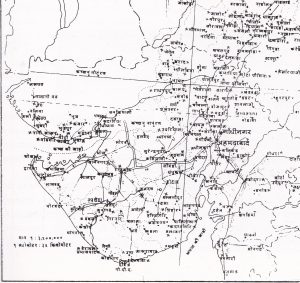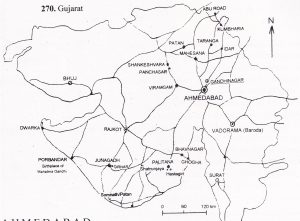Gujarat
 Three of Gujarat’s sacred Jaina sites – Kumbharia, Idar and Taranga – have already been featured in the ‘Grand Tour’ chapter (p. 154). Of the many other places only a few can be mentioned here.
Three of Gujarat’s sacred Jaina sites – Kumbharia, Idar and Taranga – have already been featured in the ‘Grand Tour’ chapter (p. 154). Of the many other places only a few can be mentioned here.
Gujarat – Gandhi – Jainism: three names that form a kind of “trinity” in the minds of many Indians and non-Indians. Carlos G. Valles, S.J., a Spaniard by birth and a Gujarati by choice, writes in his Sketches of God, written and published in Gujarat (1987), page 140: “Gandhiji hailed from Gujarat, and in this state (which is mine) Jain influence is particularly felt because, due to historical reasons, most of the Jains in India live here*, and, though in numbers they are a very small minority, their presence is felt in their faith, their prestige and their zeal.
It was through these channels that Gandhiji learned from Jainism the doctrine of non-violence; with it he obtained India’s independence through peaceful means. The greatest historic deed of our times, a country becoming independent without a war of independence, drew its basic inspiration from Jainism.”
*Naming Gujarat as the state with the most Jainas is quite common among both Indians and non-Indians. However, it is Maharashtra which has the highest number of Jainas, about twice as many as Gujarat, which, after Rajasthan, takes third place. For distribution of Jainas in India, see appendix. The editor.
 Detail of a map of India in Hindi showing the State of Gujarat. Each swastika denotes a temple or religious site sacred to Jainas, in the case of Gujarat mostly to Shvetambaras. T. T. Maps & (Courtesy Publications Ltd… Madras)
Detail of a map of India in Hindi showing the State of Gujarat. Each swastika denotes a temple or religious site sacred to Jainas, in the case of Gujarat mostly to Shvetambaras. T. T. Maps & (Courtesy Publications Ltd… Madras)
